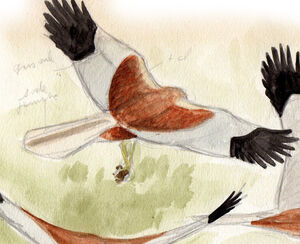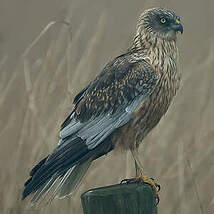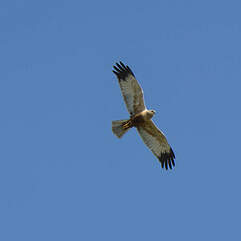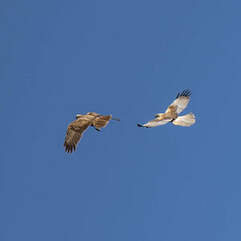Western Marsh Harrier
Circus aeruginosus - Busard des roseaux
Identification
Western Marsh Harrier is the largest of the 6 species of harriers that inhabit Eurasia. It has no equivalent on the North American continent. Like the others, it shows a marked sexual dimorphism, flying with wings raised in a V in open spaces where it hunts its prey on the ground or on the water.
The adult male in full plumage can be recognized by its variegated appearance, brown, gray, white, black ... From a distance, it looks brown with a lighter head. Up close at rest, the head has a variable background color (cream, beige, reddish, gray) and is streaked with brown. The area around the eye can be slightly darkened. The upper parts (mantle, back, rump and wing coverts) are brown with more or less light spots, especially on the coverts. The chest is often the color of the head and also mottled. Sometimes it is lighter, creamy reddish, and then contrasts sharply with the belly and thigh of a warm brown. The tail is grayish. From the wings, you usually only see the black tips, sometimes the gray of the remiges just in front. It is in flight that the variegated aspect takes on its full meaning due to the spread wings, tricolor in top view (brown, gray and black from the inside to the outside), bicolor (white and black) from below. Let's stick to that. The proximal 2/3 are lightly grayish white with the coverts slightly reddish, but from a distance it looks all white. The distal 1/3 is black with a very clear but slightly irregular border. The black concerns the ends of the primary remiges P5 to 10. The end of P3 and 4 is slightly darkened, but there is no black slip edge like in the B. Saint Martin. The tail is a very light gray. The iris is quite yellow. The wax of the beak and the long tarsi are also yellow.
The adult female is generally of a deep brown, which can appear almost black from a distance in bad light, with the head lighter which signs the species.The head is indeed cream-white with a brown band passing over the eye. The same color is found on the front of the wing at the level of the arm and often also towards the shoulder. The upper parts are entirely brown, wings and tail included, with the exception of the aforementioned pale areas. The lower parts, body and coverts, are of the same brown as above and more or less spotted with cream. Often the chest is noticeably lighter. The legs are a warmer brown. The remiges and rectrices are greyish with a glossy look. The first ones stand out well against the dark coverts. The last 6 primaries are blackish at their tips, but without the sharp contrast observed in the male. The iris color varies with age. At 2 years, it is still amber brown and will be bright yellow at 4 years or more.
The juvenile is typical. It is entirely a darker brown than the female. The head is cream with a distinct reddish hue, with a brown band starting from the eye. No clear area on the wing like the female. The large coverts, remiges and rectrices have a faint pale edge at the tip that will wear off in the autumn. In flight, it appears entirely brown with slightly darker wings and tail, in slight contrast to the coverts. The eye is brown.
The young Western Marsh Harrier in its 2nd year looks feminine. It is not easy to distinguish a one-year-old female from an older female. We will only see the male. The one-year-old young male is recognized by its already yellow iris, but it must be seen. In a top view, pay attention to the feathers. Some rectrices are beginning to grey and the same is true for the remiges but later. The remiges of the secondaries and primaries P1 to 5 have a clearly darkened tip, which causes a dark and slightly contrasting edge to the wing of the young male.The presence of melanic phenotypes complicates matters and we will not take it into consideration.
Subspecific information 2 subspecies
- Circus aeruginosus aeruginosus (Europe and the Middle East to c Asia)
- Circus aeruginosus harterti (nw Africa)
Foreign names
- Busard des roseaux,
- Aguilucho lagunero occidental,
- águia-sapeira-ocidental,
- Rohrweihe,
- barna rétihéja,
- Bruine Kiekendief,
- Falco di palude,
- brun kärrhök,
- Sivhauk,
- kaňa močiarna,
- moták pochop,
- Rørhøg,
- ruskosuohaukka,
- Europese Paddavreter (Europese Vleivalk),
- arpella comuna,
- Brúnheiðir,
- błotniak stawowy,
- niedru lija,
- rjavi lunj,
- Болотный лунь,
- Elang-rawa katak,
- ヨーロッパチュウヒ,
- 白头鹞,
- เหยี่ยวทุ่งพันธุ์ยูเรเซีย,
- 西方澤鵟〔白頭鷂,西方澤鷂〕,
Voice song and call
The Western Marsh Harrier is truly vocal only on its breeding territory. The calls are quite varied. They include insistent "siiiih siiiih..., "ouiiih ouiiih ouiiih...", etc. The alarm call is a kiek kiek kiek kiek... of an accipiter type or a kek kek kek of a pic, or a faster kinkinkinkin.... The territorial males fly in a parade while making "ouiink ouiink ouiink", spaced out and emitted with each dive/ascent in the flight. The juveniles beg with loud and insistent "piiih piiih piiih".
Habitat
The Western Marsh Harrier breeds in vegetation belts around water bodies and in marshy areas with large helophytes, in fresh or brackish water, generally on plains but up to 2000 m in Asia.
Behaviour character trait
It is a pleasure to follow the flight patterns of a pair of Western Marsh Harriers above the reedbeds they reside in, especially during their courtship displays at the beginning of the season.
The male's slow yet powerful wingbeats, alternation of diving and rising, in-flight rolls and other displays accompanied by his calls make for a great show. This is a very sociable bird: it can nest in loose colonies and polygamy has been observed. In the inter-seasonal period, it often spends the night in large groups in wetland roosts.Flight
The Western Marsh Harrier has wider wings on average than other harriers and a slightly shorter tail. The strength-bearing capacity is larger, but the weight is significantly higher. The result is a stronger musculature. Both gliding and fluttering flight are easy. The former enables it to make important migratory stops, and the second makes it easy to hunt small birds.
Dietfeeding habits
The Western Marsh Harrier is a generalist and opportunistic predator. It hunts on the wing, flying slowly and zigzagging over open aquatic and terrestrial areas.
The potential prey list is varied, but birds and small mammals predominate, the species varying obviously according to the regions of the world it frequents. In Western Europe, typical prey are young moorhens and ducks, young aquatic rodents, rats, field voles, skylarks and pipits, etc. It is willing to scavenge, for example picking up dead fish at the water's edge or dead animals on the roads. Insects are mostly hunted in winter in Africa, such as crickets.Reproduction nesting
The breeding period extends from March to August and varies depending on the region, latitude and climate.
Migrant Western Marsh Harriers arrive at their nesting sites from April to late May-early June. The species is generally monogamous, but it occasionally happens that males are polygynous. Couples nest alone or in loose small colonies. Male aerial parades are spectacular and punctuated with cries. Nesting is done by the female and the nest is often in the same area from year to year. It is built in dense herbaceous high vegetation of water belts or wetlands. The reedbed is its prototype. The nest is made of a pile of reed stems of a width of 60-80 cm and a variable height depending on the relative water level. Adults add material throughout the breeding season. The laying is 3 to 6 eggs (2-7), laid at intervals of 1-2 days and incubated by the female as soon as the first one is deposited, hence a shift in hatchings. The male alone feeds the family at first and then both adults will hunt once the young chicks have acquired homothermy. The flight takes place at 35-40 days but the young will continue to be fed while learning to hunt on their own for about 1 month. On average, 3 young ones reach the flight. They will be ready for reproduction at the age of (2)3. For migrants, the departure takes place in September and October.Geographic range
The Western Marsh Harrier occupies an important territory over 2/3 of the western Eurasian continent at middle latitudes. Its nesting area extends from the European Atlantic coast to Central Mongolia. Further away, it is replaced by the Eastern Marsh Harrier up to the Pacific. It avoids Arctic and sub-Arctic regions. It is located at SE England, North around the Baltic Sea and the south of Russia and South at the Maghreb, in Asia Minor, Iraq, Iran, Afghanistan, Central Asia and the extreme NW of China. The most southerly populations are resident. In France, it winters in the south, but not in the North. continental birds are migratory and winter either around the Mediterranean, in West Africa in Sahelian and Sub-Saharan Africa and in the Nile Valley, or in the Indian Subcontinent, up to Ceylon. Its flight power allows it to bypass obligatory passes for gliders such as Gibraltar. Satellite tracking shows a differential migration between young and adults, with the young for example migrating more to the West without crossing the Sahara.
Threats - protection
IUCN conservation status
concern
in the Wild
threatened
evaluated
At present, the species is not threatened. BirdLife International even reports it increasing in Europe. Nevertheless, it is not free from threats globally, such as poaching, poisoning, in particular through dead animals, habitat degradation, draining or drying of wetlands, burning or planting of reeds, etc.
Sources of information
- IOC World Bird List (v15.1), Gill, F and D Donsker (Eds). 2025-12-07.
- The Raptors of Europe and The Middle East, Forsman Dick
- Raptors of the World, a field guide, Ferguson-Lees James et Christie David
- BirdLife International, BirdLife International
- Birds of the World, The Cornell Lab of Ornithology
- xeno-canto, Sharing bird sounds from around the world,
Other sources of interest
 Specification sheet created on
21/07/2023 by Jean François
Specification sheet created on
21/07/2023 by Jean FrançoisTranslation by AI Oiseaux.net
© 1996-2025 Oiseaux.net
- Accipitriformes
- Aegotheliformes
- Anseriformes
- Apodiformes
- Apterygiformes
- Bucerotiformes
- Caprimulgiformes
- Cariamiformes
- Casuariiformes
- Charadriiformes
- Ciconiiformes
- Coliiformes
- Columbiformes
- Coraciiformes
- Cuculiformes
- Eurypygiformes
- Falconiformes
- Galliformes
- Gaviiformes
- Gruiformes
- Leptosomiformes
- Mesitornithiformes
- Musophagiformes
- Nyctibiiformes
- Opisthocomiformes
- Otidiformes
- Passeriformes
- Pelecaniformes
- Phaethontiformes
- Phoenicopteriformes
- Piciformes
- Podargiformes
- Podicipediformes
- Procellariiformes
- Psittaciformes
- Pterocliformes
- Rheiformes
- Sphenisciformes
- Steatornithiformes
- Strigiformes
- Struthioniformes
- Suliformes
- Tinamiformes
- Trogoniformes


































